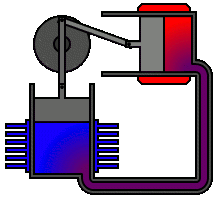wikipedia | Thermoacoustic engines (sometimes called "TA engines") are thermoacoustic devices which use high-amplitude sound waves to pump heat from one place to another, or conversely use a heat difference to induce high-amplitude sound waves. In general, thermoacoustic engines can be divided into standing wave and travelling wave devices. These two types of thermoacoustics devices can again be divided into two thermodynamic classes, a prime mover (or simply heat engine), and a heat pump. The prime mover creates work using heat, whereas a heat pump creates or moves heat using work. Compared to vapor refrigerators, thermoacoustic refrigerators have no ozone-depleting or toxic coolant and few or no moving parts therefore require no dynamic sealing or lubrication.
 wikipedia | The Stirling cycle is a thermodynamic cycle that describes the general class of Stirling devices. This includes the original Stirling engine that was invented, developed and patented in 1816 by Reverend Dr. Robert Stirling with help from his brother, an engineer.[1]
wikipedia | The Stirling cycle is a thermodynamic cycle that describes the general class of Stirling devices. This includes the original Stirling engine that was invented, developed and patented in 1816 by Reverend Dr. Robert Stirling with help from his brother, an engineer.[1]
The cycle is reversible, meaning that if supplied with mechanical power, it can function as a heat pump for heating or refrigeration cooling, and even for cryogenic cooling. The cycle is defined as a closed-cycle regenerative cycle with a gaseous working fluid. "Closed-cycle" means the working fluid is permanently contained within the thermodynamic system. This also categorizes the engine device as an external heat engine. "Regenerative" refers to the use of an internal heat exchanger called a regenerator which increases the device's thermal efficiency.
The cycle is the same as most other heat cycles in that there are four main processes: 1.Compression, 2. heat-addition, 3. expansion and 4. heat removal. However, these processes are not discrete, but rather the transitions overlap.
 wikipedia | The Stirling cycle is a thermodynamic cycle that describes the general class of Stirling devices. This includes the original Stirling engine that was invented, developed and patented in 1816 by Reverend Dr. Robert Stirling with help from his brother, an engineer.[1]
wikipedia | The Stirling cycle is a thermodynamic cycle that describes the general class of Stirling devices. This includes the original Stirling engine that was invented, developed and patented in 1816 by Reverend Dr. Robert Stirling with help from his brother, an engineer.[1]The cycle is reversible, meaning that if supplied with mechanical power, it can function as a heat pump for heating or refrigeration cooling, and even for cryogenic cooling. The cycle is defined as a closed-cycle regenerative cycle with a gaseous working fluid. "Closed-cycle" means the working fluid is permanently contained within the thermodynamic system. This also categorizes the engine device as an external heat engine. "Regenerative" refers to the use of an internal heat exchanger called a regenerator which increases the device's thermal efficiency.
The cycle is the same as most other heat cycles in that there are four main processes: 1.Compression, 2. heat-addition, 3. expansion and 4. heat removal. However, these processes are not discrete, but rather the transitions overlap.


0 comments:
Post a Comment